In 1966, the Chrysler Windsor was the Canadian-built equivalent of the Newport model in the US. Unsurprisingly, Windsors were built in the Windsor, Ontario plant. Unlike today where vehicles are assembled from components manufactured all over the world, these cars were substantially “Made in Canada” from Canadian-made parts. The ink was still fresh on the Canada-US auto pact, which would soon change that arrangement, and 1966 was the last year for the Windsor model name.

Canadian magazine ad featuring the Windsor two-door hardtop.
According to the original owner, my Windsor 2-door hardtop was a factory-ordered car, but the deal fell through, and so it wound up on the dealer’s lot. The colour was Saddle Bronze metallic, with matching interior. The drivetrain consisted of the base engine, a big block 383 2-barrel with 9.2:1 compression, rated at 270hp. This was mated to the venerable Torqueflite 727 3-speed automatic, and 2.76:1 “economy” gearing in the differential. Inside was the standard column shifter and bench seats.
Options included power steering and brakes, AM radio, clock, rear window defogger, fender-mounted turn signal indicators and an accessory light package.

The original purchaser was a gentleman from Georgetown, Ontario, but it was primarily his wife’s car. She only drove the car around town, so every week or two he would grab the keys and take the Chrysler out on the highway to “stretch its legs.” It was “restored” (to a not particularly high standard) and repainted in the mid-80’s, shortly before it was sold in 1988.

My Windsor and my brother’s New Yorker.
The car changed hands a few times, finally being acquired by another older gentleman whose family bought it for him as a surprise. They mistakenly believed it was the same car he had owned in his youth. At that time, the front frame rails were getting rough, a common problem with fullsize Mopars of this vintage. He welded sheetmetal patches over the holes and called it good. In 1999, he gave the car to his grandson.

Picture from the 1999 Auto Trader ad for my Windsor.
The grandson drove it just long enough to get it covered in winter road salt. He liked to drive around in second gear to hear the engine wind-out. It had also developed some mechanical problems. Between the broken distributor vacuum advance, choke that was stuck part-way on, and the burned exhaust valves, the kid’s fuel bill must have been horrendous. There were also maladies in the suspension and brakes. I don’t even know how he actually drove the car with all these problems.
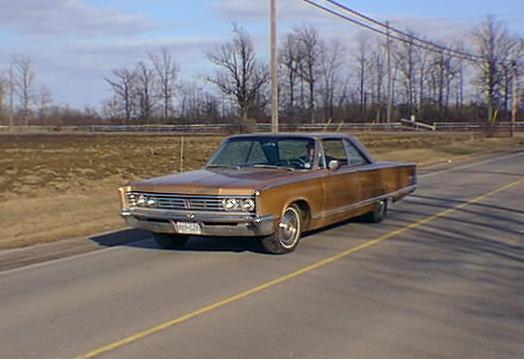
As purchased, February 2000.
However, before this individual could ultimately destroy the car, fate intervened in the form of a minor carburetor fire. It was just bad enough that the venturis partly melted. The engine would still run, but not very well. He took it to a shady used car dealer in Toronto and traded it on a Dodge Colt. The dealer didn’t even wash off the road salt before taking the picture which ran in Auto Trader. The asking price was $3000.
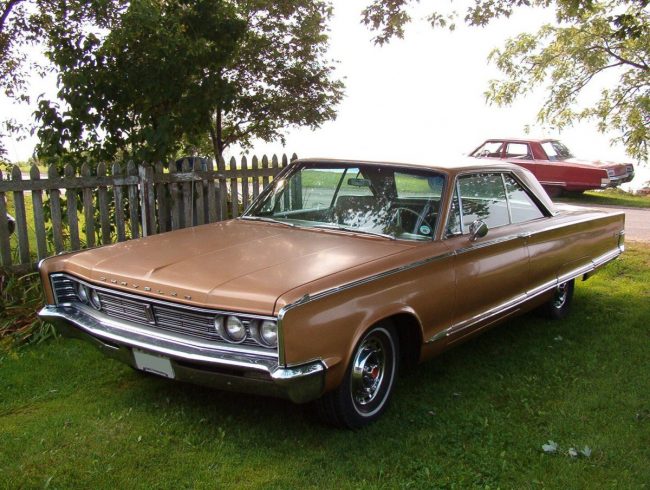
Two Windsors. My brother briefly got our Dad’s Chrysler roadworthy. Picture from 2003.
In December, 1999 I spotted the ad in Auto Trader. My dad’s 1966 Chrysler Windsor sedan project car sat languishing in his garage, virtually untouched since 1991. A more in-depth look at my dad’s Chrysler is a story for another day but at the time, it was obvious that it was going nowhere. I reasoned that he should buy another Chrysler with a better body and transplant the drivetrain from his car, which was still mechanically excellent, into it. He humored me as far as driving to Toronto to check the two-door out. The dealer never did wash the road salt off it, nor did he move any cars out of the way so we could actually test drive it. He started the engine briefly, but it was only running on 7 cylinders and filling their shop with acrid exhaust smoke. I told him this was no $3000 car. He asked me what I thought it was worth and I replied $1500. We left, and that was that.
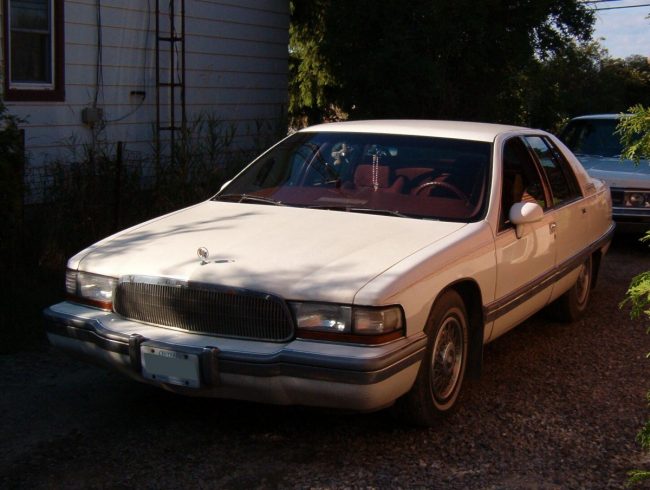
I had recently graduated from school and had started my fulltime Engineering career. My dad wanted me to buy my mom’s summer car, a 1992 Buick Roadmaster. I had encouraged my parents to buy it in the first place and still liked the Roadmaster, but it was just a stand-in for what I really wanted: a 1966 Chrysler. After coming to that realization, I called the dealer back and started haggling to buy the Windsor for myself. He strung me along for a long time, hoping to find a bigger sucker no doubt, but ultimately I got the car for $1600(+tax) certified and “legally” ready to drive. This was in February of 2000, just before my 25th birthday. After handing over the money, the dealer admitted I was the only person that had been seriously interested in the car. Several others had come to see it, assuming it would be about the size of a Coronet, and were immediately turned off when they saw how BIG it was.

Installing cylinder heads. (July 30, 2000)
My Dad was very supportive, which was great because I quickly started to think I had made a poor decision. We diagnosed and tended to the immediate mechanical problems. Aside from the burned exhaust valves, which we would tend to the following summer, my Chrysler was “mechanically” ready to drive! It was still winter, but there was a long dry spell and the roads were clear of snow and road salt, so I had an opportunity to drive the car for a bit before parking it until spring.

Visiting a friend’s farm. (Summer, 2000)
Shortly after buying my Windsor, my dad gave me some useful advice: Don’t tear into the car and disassemble everything, or you’ll get overwhelmed and discouraged, and the car will likely wind-up a basket case. Fix one thing at a time and return the car to a drivable state as soon as possible (my own family history is replete with examples of what can happen otherwise). This advice has served me very well over the years, though sometimes it has meant spending more money in order to reduce downtime.

Stopped at the Swigart Museum on the way home from Carlisle. (2007 photo)
Initially my Windsor was my summer daily driver. I would park it occasionally to work on something, but it was always back on its wheels in short order. Until 2006, I didn’t have a garage to work in. I paid for indoor winter storage, but the car wasn’t accessible to work on when in storage. I took it to lots of car shows and cruise nights as well. The furthest I’ve driven it was to Carlisle, Pennsylvania for the annual All Chrysler Nationals car show and swap meet

One of the first things I did to personalize my car was swapping in a set of factory-correct bucket seats and a floor-shift console from a Chrysler that was being parted out. I had the seats reupholstered to match my saddle bronze interior, and installed everything myself in the summer of 2001.
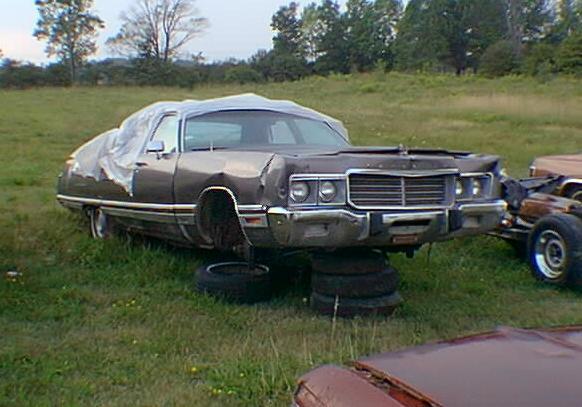
My next big modification was front disc brakes in 2003. To that end, I bought a 1973 New Yorker Brougham parts car. Disc brakes specifically from a 1973 C-body Mopar are the preferred upgrade for older C-bodies. They are almost a bolt-in upgrade, and are much easier and cheaper to maintain than the Budd discs which were optional in 1966. I also acquired the correct wheel covers which would have been fitted to a 1966 Chrysler with disc brakes.

Ye olde 383. Canadian-built big blocks were painted red, not turquoise.
I made some mild performance modifications to the engine, but the original 383 was getting pretty tired. When we had had the cylinder heads off, my dad honed the cylinder walls and found they were pretty badly worn. By 2003, they had finally gotten to the point that there was considerable blow-by and the exhaust puffed a hint of blue oil smoke.

The beast on the dyno. (2004 photo)
Not content with a stock rebuild, I decided that a performance engine was called for. I opted to buy another block and only swap engines once completed. I read everything I could get my hands on relating to building high performance engines, and had a good idea what I was getting into. I acquired most of the parts I would need from the classifieds, swap meets and online.

Installing the new engine. (2004 photo)
I had never built an engine before though, and still had no garage to work in, so I ultimately contracted a reputable performance shop to do the machining work, assemble the engine and break it in on their dyno. Then my brother and I performed the engine swap in my driveway in the summer of 2004. We bolted it up to the stock original 727 transmission.

One mile to go! (August 20, 2005)
The odometer rolled over 100,000 miles back to zero in August, 2005. The day was particularly memorable, as I was on my way home from the New Hamburg Moparfest, the largest all-Mopar car show in Canada.

In 2006, my wife and I bought a house in the country, finally giving me a garage to work in! I keep one of my Chryslers in the garage at home over the winter to work on. I store the other one elsewhere in the winter, but always have the second bay cleaned-up in the spring to make room for it to come home. Some winter projects on my Windsor have included swapping the cast iron exhaust manifolds for a set of headers, replacing the 2.76 rear gears for 3.23’s with a Dana Suregrip, and modifying the transmission with a shift kit and part-throttle kickdown module.

The original front subframe: A bad case of tinworm.
Mechanically the car was just about where I wanted it, but with so much power on tap, I was getting worried about my crudely patched front subframe. The old bodywork repairs were starting to look shabby as well. When I discovered that one of the body mounts had rotted out, I decided that the time had come to replace the subframe and restore the bodywork. This would be a huge undertaking, for which I had been planning and collecting parts for years.

1966 Chrysler Newport parts car, front subframe unbolted.
The front subframe of a C-body Mopar is removable; it bolts to the unibody structure. I had acquired a couple of 1966 Newport sedan parts cars with excellent subframes. Both cars had originally come up from the US, and were in very good condition, aside from a tree having fallen on one of them.

Preparing the front subframe.
My project for the winter of 2010 was to refurbish one of my good front subframes. After disassembling the front suspension, I took it to be chemically stripped at a shop that specializes in such work, and had it powder coated. Then I reassembled it with brand new heavy-duty everything. I temporarily added some drum brake assemblies so I could bolt-on a couple wheels to move it around.

I had gone about as far as I could without tearing into the car itself. I was apprehensive because this would be a multi-year restoration, and my car would be immobile for much of that time. I reflected on the absurdity the entire endeavor; it would be cheaper to buy another Chrysler instead and use mine for parts, much as I had tried to convince my dad to do back in 1999. For a variety of reasons, I resolved to stay the course and restore my Windsor. I began the next phase in October, 2011.
To be continued…eventually!
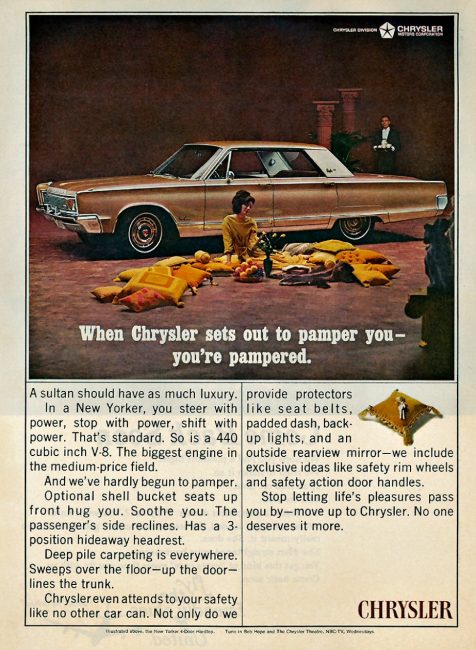

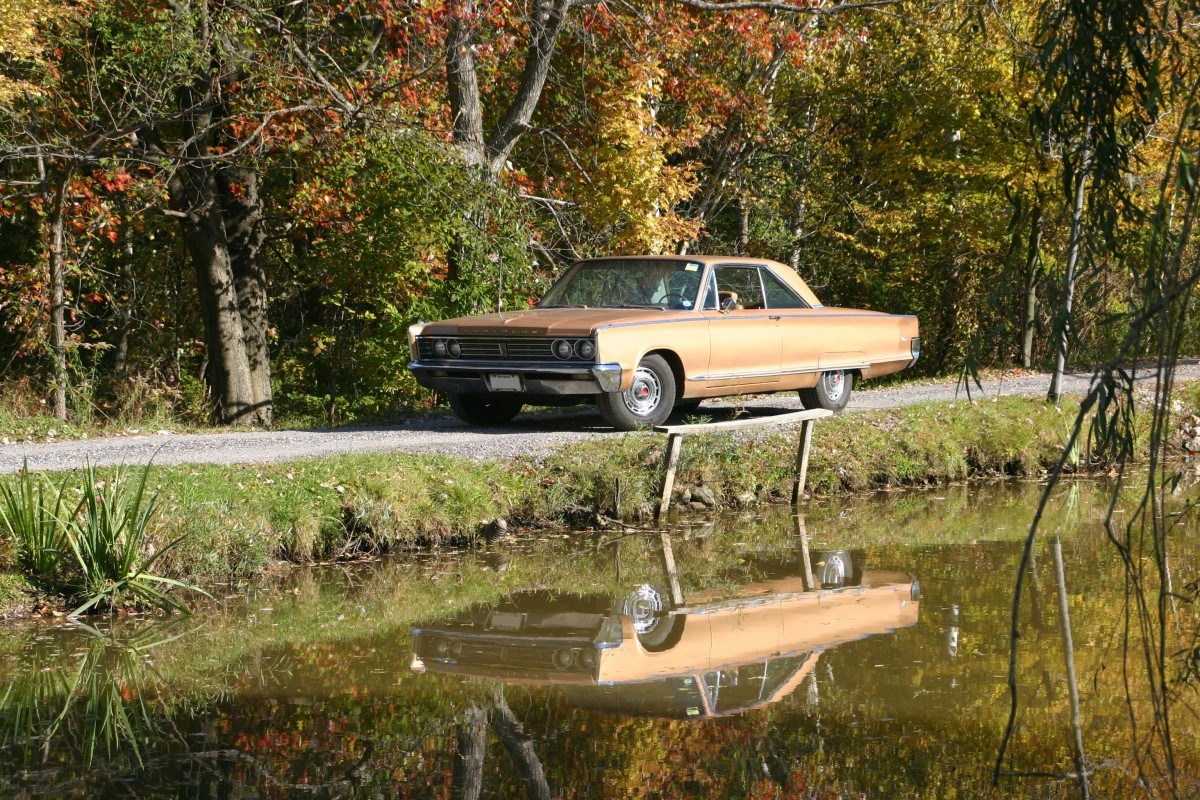






16 Comments
Nice write-up, I enjoyed it. Good luck with the restoration.
Do you think anyone will be able to rebuild today’s cars 50-odd years from now in the same way?
It’s great to see old drivers get some love. Particularly old Mopars for which I’ve had a few. My current old driver is a ’63 Thunderbird and this reminds me that I’ve got a few things to fix and put some more miles on it.
I wonder why restorations of cars like this always come with a big performance upgrade. No doubt the 383 is capable of far more than 270 gross horsepower, but lets face it, that is plenty of power for this type of car. In adding the power, you are making the car loud perhaps to the point of making a spectacle of yourself driving it. This is the direct opposite of what Chrysler intended. There was a reason for the 2 barrel and relaxed gearing with the big engine. It could be relaxed in a way lesser cars couldn’t. This then reflected the taste and discretion of the owner. I know not modern, but if you wanted modern with an old pastiche, Dodge will sell you a Canadian assembled Challenger.
“I wonder why restorations of cars like this always come with a big performance upgrade.”
Probably because buying an actual “performance” optioned car from this era tends to require a lot more up front money. I doubt he could have picked up a ’66 440TNT, 3.23 Sport 300 for $1600.
In Canada, the hot big Mopar 66 is probably a Fury I with the slant 6 and three on the tree.
Cars of this era are a lot slower than the advertised horsepower might suggest. Most owners like a little performance to go with their terrible fuel mileage. The performance upgrades don’t have to be obnoxious though. A subtle choice in mufflers can make for a speedy-quiet ride.
Automobile-catalog.com had Mike’s engine, axle ratio in a probably slightly heavier 66 Newport (4120 pounds). 9.2 seconds to 60 with a 119 mph top speed. The 29 mph/1000 rpm top gear with the big engine would have seemed pretty relaxed at 2400rpm at 70mph right at the engines ample torque peak. The four barrel option at 325 gross horsepower got to 7.6 seconds to 60 assuming that guy’s logarithm properly takes into account period tire traction. Mike’s description sounded like far more than a 4 barrel conversion and you can see his tires are filling the wheel wells much more than the black and white ad shot of the stock car.
Because we can.
I have a Ford 5.0 pushrod motor that I going to redo the bottom end on. Probably less than 500 extra will get me a 331 stroker motor.
Of course, we always forget that with extra power comes more heat, and broken parts.
–Stephen
Of course you can, the question is if you should? This Chrysler for example came on 14 inch wheels. It was part of the long and low look so alien today. When Mike has the Windsor back together with what 400? rumbling horsepower, he will have to put modern circa 18 inch wheels on it to possibly launch from a stoplight. Now it is not only stupidly loud, but donked, and arguably spitting at the style of the first owner. Maybe Nick Nolte pulls that off in “48 hours”, but most of those since come off as fools who pearls have mistakenly been cast before them. Boomers pissing at WWII people is getting ever more pathetic Of course it is then still slower than the kid in a same price old Lancer Evolution which in my mind people in this mindset are welcome to.do whatever they want to.
Yes, how dare he restore his car the way he wants without consulting you.
If only people would consult me… imagine all the foolishness avoided.
It would be challenging to put 18’s on that car. I run 14’s on my car and it is getting very difficult to find new tires. Pretty much have to go mail order. I am running bigger tires on the rear so I can have a bit of rake. Never liked the ’60’s nose high look
One of these days I will write up an article about my car
–Stephen
Mike’s car was finished this year, it has the same wheels, tires and Chrysler wheel covers now as it did before. It looks terrific. It’s not hot rodded. Not that I even need to defend how he spends his money or builds his car however he likes.
What a great choice of vintage MoPar to keep on the road ! .
Keep us posted, I wish I was closer to buy you a tank of fuel and a nice dinner far away so I could get a ride in it .
-Nate
My, my ~ such vitriolic tirades about nothing .
The person who foots the bill is the one who’s ideas count .
Me, I like to drive, a _lot_ not just shredding tires ’round town and to the weekend show & shine so I prefer fairly low compression engines that are closely balanced and have CC’d combustion chambers, matched ports to exhaust manifolds and so on so there’s plenty of power for the steep hills and mountains if not tire burning thrust from a dead stop .
To each their own, saying ‘your way is bad’ unless you’re lighting it on fire and destroying it, is silly .
The fun thing is : in the drivers groups I run with there are always those who simply must have the biggest, loudest , tire shreddingest, best handling vehicles yet except in straight lines I’m usually far ahead of them .
The only thing I think is foolish is making your ride so extreme you no longer enjoy driving it and this car appears to be well enjoyed by it’s owner so that’s moot .
God knows it’s _beautiful_ to this old fart .
Now, GET OFFA MY DAMN LAWN ! .
-Nate
Well stated sir!